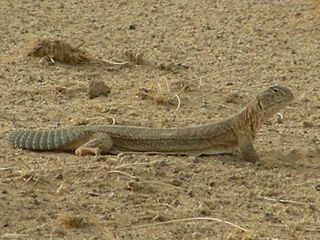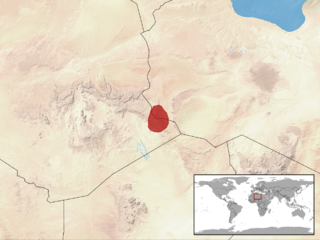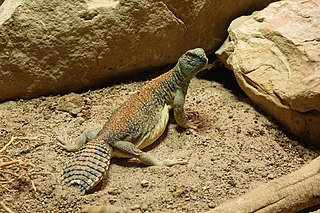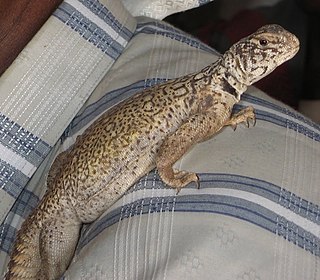
Uromastyx is a genus of African and Asian agamid lizards, the member species of which are commonly called spiny-tailed lizards, uromastyces, mastigures, or dabb lizards. Lizards in the genus Uromastyx are primarily herbivorous, but occasionally eat insects and other small animals, especially young lizards. They spend most of their waking hours basking in the sun, hiding in underground chambers at daytime, or when danger appears. They tend to establish themselves in hilly, rocky areas with good shelter and accessible vegetation.

The eastern bearded dragon, also known as common bearded dragon or simply bearded lizard, is an agamid lizard found in wooded parts of Australia. It is one of a group of species known commonly as bearded dragons. Other common names for this species include Jew lizard and frilly lizard, the latter being a confusion between this and another dragon, the frill-necked lizard. This species was originally described in 1829 by Georges Cuvier, who named it Amphibolurus barbatus.

Saara hardwickii, commonly known as Hardwicke's spiny-tailed lizard or the Indian spiny-tailed lizard is a species of lizard in the family Agamidae. The species is found in patches across the Thar desert, Kutch, and surrounding arid zones in India and Pakistan. It is mainly herbivorous and lives in numbers in some areas. Since it is found in loose clusters it often attracts predators such as raptors. It is also hunted by local peoples in the belief that the fat extracted from it is an aphrodisiac.

Uromastyx alfredschmidti, commonly known as the ebony mastigure, Schmidt's mastigure, or Schmidt's spiny-tailed lizard, is a species of lizard in the family Agamidae. The species is indigenous to North Africa.

The common agama, red-headed rock agama or rainbow agama is a species of lizard from the family Agamidae found in most of sub-Saharan Africa. To clear up historical confusion based on Linnaeus and other authors, Wagner, et al. (2009) designated a neotype for the species, using a previously described specimen from Cameroon in the collection of the Zoologisches Forschungsmuseum Alexander Koenig in Bonn. The species name was formerly applied to a paraphyletic collection of taxa, and mitochondrial DNA analysis of various populations indicates they represent separate species., Consequently, three former subspecies A. a. africana, A. a. boensis, and A. a. mucosoensis are now considered separate species, and A. a. savattieri is considered synonymous with A. africana.

Uromastyx princeps, commonly known as the princely mastigure, princely spiny-tailed lizard, or Somalian mastigure, is a species of lizard in the family Agamidae.

Uromastyx aegyptia is a species of lizard in the family Agamidae. The species is endemic to North Africa and the Middle East.

Uromastyx dispar flavifasciata is a subspecies of spiny-tailed lizard belonging to the family Agamidae. It is found in rocky, arid and desert habitats in North Africa, its range including parts of Algeria, Mali and Niger. While sometimes considered a separate species, other treat it as a subspecies of Uromastyx dispar.

Uromastyx ornata, commonly called the ornate mastigure, is a species of lizard in the family Agamidae.

Ctenophorus pictus, commonly known as the painted ground-dragon or painted dragon, is a species of lizard from the family Agamidae. It is endemic to the drier areas of southern and central Australia.

Gonocephalus doriae is a species of arboreal lizard in the family Agamidae. The species is endemic to the island of Borneo.

Uromastyx thomasi, the Omani spiny-tailed lizard or Thomas's mastigure, is a species of agamid lizard. It is found in Oman.
Mesalina pasteuri, also known commonly as Pasteur's lizard, is a species of sand-dwelling lizard in the family Lacertidae. The species is endemic to North Africa.

Uromastyx ocellata is a species of agamid lizard native to northeastern Africa. It is known as the ocellated spinytail, eyed dabb lizard, and ocellated uromastyx.

Saara asmussi, also known commonly as the Iranian mastigure and the Persian spiny-tailed lizard, is a species of lizard belonging to the family Agamidae. The species is endemic to Asia.

Acanthocercus adramitanus, also known commonly as Anderson's rock agama or the Hadramaut agama, is a small species of lizard in the family Agamidae. The species is endemic to the Arabian Peninsula.
Xenagama wilmsi, the Wilms' agama, shield-tail agama, or turnip-tail agama, is a species of lizard in the family Agamidae. The species is endemic to the Horn of Africa.

Uromastyx acanthinura, the North African mastigure or North African spiny-tailed lizard, is a species of agamid lizard. It is found in Morocco, Algeria, Tunisia, Libya, Egypt, Western Sahara, Chad, Mali, Niger, and Sudan.

Uromastyx benti, also known commonly as Bent's mastigure and the Yemeni spiny-tailed lizard, is a species of lizard in the family Agamidae. The species is native to the southeastern Arabian Peninsula.
Uromastyx yemenensis, the South Arabian spiny-tailed lizard, is a species of agamid lizard. It is found in Yemen.



















